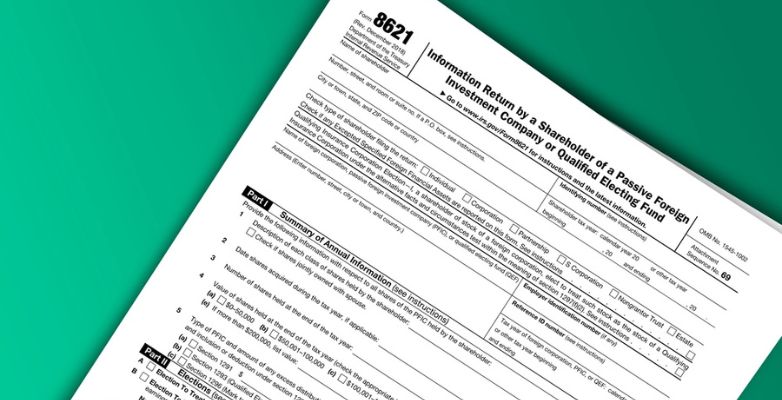Learn more about IRS Form 8621 without tax specialists if you must declare income for foreign mutual funds (PFICs). You may have a foreign mutual fund investing account if you are an American citizen who lives and works abroad. You must use U.S. tax Form 8621 to declare any income you got from these funds in the previous year. Income from foreign mutual funds, also known as passive foreign investment firms (PFICs), is reported on tax form 8621, Information Return by a Shareholder of a Passive Foreign Investment Company or Qualified Electing Fund. So without wasting time, let’s go through the blog and learn about the U.S. Tax Form 8621 for Shareholders of passive foreign investment companies.
Table of Content
About IRS Form 8621
A passive foreign investment firm (PFIC)’s direct or indirect shareholders in the United States must submit Form 8621 if they:
- Get specific direct or indirect payments from a PFIC.
- Realize a profit when you sell PFIC stock, whether directly or indirectly.
- Are submitting data regarding a mark-to-market choice made under section 1296 or a QEF.
- Are adding reporting requirements for elections in Part II of the form.
- Are required by section 1298(f) to submit an annual report.
What is IRS Form 8621 Used For?
Income from foreign mutual funds, also known as passive foreign investment companies (PFICs), is reported on tax form 8621, Information Return by a Shareholder of a Passive Foreign Investment Company or Qualified Electing Fund.
What qualifies as a PFIC?
Most foreign mutual funds fall under the definition of PFIC. Mutual funds with foreign locations are frequently set up as or presumed to be businesses under U.S. tax law. However, a PFIC is not just restricted to mutual funds; any pooled investment that is registered outside of the United States would be considered a PFIC, including various kinds of funds, investment trusts, ETFs, and more.
If a foreign corporation qualifies either of the two requirements listed below, it is considered a PFIC:
- Its gross revenue for the tax year must be at least 75% passive income, which is typically earned from investments like interest, dividends, royalties, rentals, and annuities, or
- The company holds at least 50% of its assets to produce passive income.
As long as the necessary filing threshold is fulfilled, PFICs are still reportable even in the absence of revenue. For example, a taxpayer with no PFIC income but PFICs worth more than $25,000 must register the PFICs on Form 8621. Excess distribution, mark to market (MTM), and qualified electing fund (QEF) are the three ways that PFICs are taxed.
Who Must Use IRS Form 8621?
Unless there is a distribution of income from a passive foreign investment company (PFIC) in which a U.S. person is a shareholder or disposal of the shares of a PFIC by gift, death, or the majority of other tax-free exchanges or redemptions, this form is not required to be filed. However, neither in the form’s instructions nor in the relevant IRS regulations will taxpayers or preparers find a statement to this effect.
To calculate the tax owed on any excess distributions from or disposal of a PFIC, the form must be submitted. An excess distribution is typically defined as a distribution that, after the first year, is greater than 125% of the distribution that was typical over the previous three years. All dispositions seem to be treated the same as distributions that are more than 125% of the average distributions and are therefore treated as excess distributions.
In most situations, if there are excess distributions or the taxpayer wishes to choose a current method of taxation, a U.S. person who has a direct or indirect ownership interest in a PFIC is required to complete this form. A partner in any partnership that owns any PFIC shares as well as a beneficiary of any trust or estate that does would both be considered indirect owners.
Anyone with investments in a foreign partnership that does not hold any shares of any PFIC should not use this form. Even if 100% of a partnership’s income comes from passive assets, it is not a PFIC. The same holds true for any trust or estate that doesn’t possess any PFIC shares. By definition, a PFIC is a corporation; a trust or partnership would typically not be a PFIC. (In some cases, the IRS would contend that a foreign trust or foreign partnership exhibited corporate features.)
U.S. shareholders of a controlled foreign corporation that meets the criteria for a PFIC are subject to a particular rule. As long as they are subject to tax on the investment income of the CFC, U.S. shareholders of a controlled foreign corporation (CFC) that is a foreign personal holding company (or otherwise satisfies the requirements of a PFIC) shouldn’t file a Form 8621. However, if the CFC holds shares in a PFIC, it might be obliged (or given the option) to submit this form, in which case the PFIC’s earnings would be distributed to the U.S. shareholders via the CFC.
When the single U.S. owner of a foreign corporation chooses to have the foreign corporation treated as a disregarded entity and the foreign corporation has not invested in a PFIC, the requirement to file this form to pay tax on the current income of a PFIC can be avoided.
Beneficiaries of a foreign trust should not submit this form unless the foreign trust has made an investment in a PFIC. The IRS may, however, consider a foreign trust to be a PFIC if it has the characteristics of a corporation. The PFIC is specifically referred to as a corporation in the IRC, the IRS Regulations, and the IRS instructions to Form 8621. A taxpayer should not have to assume that a trust should be treated the same as a company.
Who Files Form 8621?
You might need to submit tax Form 8621 if you are a direct or indirect shareholder of a PFIC and you either received a distribution of income or have reached the required filing threshold.
You are eligible if
- A PFIC sends you certain direct or indirect distributions.
- You made money when you sold PFIC stock, either directly or indirectly.
- You are providing details regarding a section 1296 mark-to-market election or a QEF.
- In Part II of the form, you are making an election that must be reported.
- You have more than the $25,000 threshold.
What makes you an indirect shareholder is as follows:
- You own at least 50% of a foreign corporation that isn’t a PFIC but that indirectly or directly owns PFIC shares.
- You own shares of a PFIC that is also a stakeholder in another PFIC, and vice versa.
- If a domestic corporation that you possess at least 50% of owns a section 1291 fund, you are that domestic corporation’s largest shareholder.
- A pass-through entity is owned directly or indirectly by you, and the pass-through entity itself is a direct or indirect shareholder of a PFIC. See Regulations section 1.1291-1(b)(8) for more details on assessing whether a U.S. person is an indirect shareholder.
Penalties for Not Filing
There could be consequences if you fail to submit Form 8621 even though you are required to. Penalties for failing to file Form 8621 are not that simple. Although you are not immediately punished for failing to file when you are required to, you do expose yourself to future audits.
IRS Form 8621 Filing Requirements
The 8621 form is used when a person has a PFIC (Passive Foreign Investment Company), which is formally known as an Information Return by a Shareholder of a Passive Foreign Investment Company or Qualified Electing Fund.
The IRS could feasibly audit the return indefinitely if this form is not filed, resulting in one of the stiffest penalties imaginable. Your return will now be subject to a variety of penalties.
As you may expect, form 8621 is somewhat complicated. You should not rely on this as a guide when creating your own form because it is not one.
Foreign Investments Reported on Form 8621
If a foreign corporation passes either the income test or the asset test outlined below, it qualifies as a PFIC.
Income Test
For its taxable year, the corporation’s gross revenue must consist of at least 75% passive income (as that term is defined in section 1297(b)).
For Example: if a foreign corporation receives all of its revenue from investments—such as buying stocks, securities, ETFs, etc. And that income is all the result of passive methods, the foreign firm would be regarded as a PFIC for tax purposes. Contrarily, if you own your own consulting company that is a business and you receive all of your revenue as a result of your consulting skills, you are generating earned income and would likely be able to avoid the PFIC label - absent other facts.
Asset Test
At least 50% of the average percentage of assets owned by the foreign corporation during the taxable year (as determined by section 1297(e)) are assets that generate passive income or are intended to generate passive income.
Example: Consider a foreign firm that merely holds foreign real estate and earns passive revenue. In this example, all of the real estate held by the corporation is used to generate passive income, making the rental income passive income and making up at least 50% of the assets in the corporation. Given that at least 50% of the assets are being used to create passive income, this would likely be a PFIC.
Threshold for Reporting PFIC
Since the regulations were changed in 2012, all PFICs must now be disclosed each year when the threshold requirement is satisfied, regardless of whether any income was transferred or not. Depending on whether the person is filing as a single person, a married couple filing separately, or a married couple filing jointly, different minimum threshold requirements apply.
If a person has more than $20,000 in PFICs in any given year, whether they are single, married filing separately, or both, they must submit Form 8621. As a result, all PFICs would need to be disclosed if you had one PFIC worth $50,000 or eight PFICs at $5,000 each. This would satisfy the threshold requirements in either case.
However, in general, unless there were distributions, it may not be required to be disclosed if, for instance, a person only owned one PFIC and it was only worth $19,000.
The same principle applies to couples filing jointly if their total ownership of PFICs exceeds $50,000.
When a Taxpayer is below the 25K/50K with no distributions, there is a difference between the Regulation and Instructions regarding whether Form 8621 (Pre-Part I) is necessary.
What Does Form 8621 Look Like?
Form 8621 is an example of the form that follows. Each investment that qualifies as a PFIC is required to submit a separate form; as a result, if you own 10 foreign mutual funds, you would be required to submit 10 forms, each of which must include the personal data of the Shareholder, the type of shares held (Part I), and the method you intend to use to tax the PFIC (Part II).
Conclusion
Hopefully, now you are able to understand the U.S. Tax Form 8621 for Shareholders of Passive Foreign Investment Companies. We have mentioned all the important steps above. But still, if you face any kind of issue related to this blog then you can call the help desk team.
Frequently Asked Questions
In the US, how is a PFIC taxed?
Yes. Gains and distributions from PFICs must be reported on IRS Form 8621 as ordinary income since they are considered to be such.
Is 8621 needed?
It’s possible that you have a foreign mutual fund investing account if you are an American citizen who lives and works abroad. You must use U.S. tax Form 8621 to declare any income from these funds in the previous year.
Are overseas investors subject to US taxes?
International stock market investors are, like other investors, taxed on any capital gains or dividends they receive.




